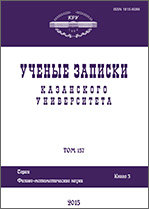|
|
Uchenye Zapiski Kazanskogo Universiteta. Seriya Fiziko-Matematicheskie Nauki, 2016, Volume 158, Book 2, Pages 231–242
(Mi uzku1365)
|
 |
|
 |
This article is cited in 7 scientific papers (total in 7 papers)
Dependence of vapor compression in cavitation bubbles in water and benzol on liquid pressure
A. A. Aganina, M. A. Ilgamovb, D. Yu. Toporkova
a Institute of Mechanics and Engineering, Kazan Science Center, Russian Academy of Sciences, Kazan, 420029 Russia
b Mavlyutov Institute of Mechanics, Ufa Science Center, Russian Academy of Sciences, Ufa, 450054 Russia
Abstract:
The features of strong vapor compression inside cavitation bubbles in benzol during their collapse have been studied depending on the liquid pressure in the range from 0.15 through 15 bar (the liquid temperature is $20^\circ$ C, the initial radius of the bubble is $500~\mu\mathrm m$). It has been found that three scenarios are implemented in this range of the liquid pressure: nearly homogeneous compression, compression by the radially converging simple waves, and compression by the radially converging shock waves. Shock waves are formed inside the bubble when the liquid pressure exceeds 0.25 bar. In contrast to benzol, there is only one possible scenario implemented in the case of cavitation bubble collapse in water under the same conditions, i.e., nearly homogeneous compression.
Keywords:
acoustic cavitation, bubble dynamics, bubble collapse, cumulation, converging shock waves.
Received: 03.02.2016
Citation:
A. A. Aganin, M. A. Ilgamov, D. Yu. Toporkov, “Dependence of vapor compression in cavitation bubbles in water and benzol on liquid pressure”, Uchenye Zapiski Kazanskogo Universiteta. Seriya Fiziko-Matematicheskie Nauki, 158, no. 2, Kazan University, Kazan, 2016, 231–242
Linking options:
https://www.mathnet.ru/eng/uzku1365 https://www.mathnet.ru/eng/uzku/v158/i2/p231
|

|




 Contact us:
Contact us: Terms of Use
Terms of Use
 Registration to the website
Registration to the website Logotypes
Logotypes








 Citation in format
Citation in format 
